Research Trends in Advanced Glycation End Products and Obesity: Bibliometric Analysis
Abstract
1. Introduction
2. Materials and Methods
2.1. Phase I—Identification of Data Sources and Search Criteria
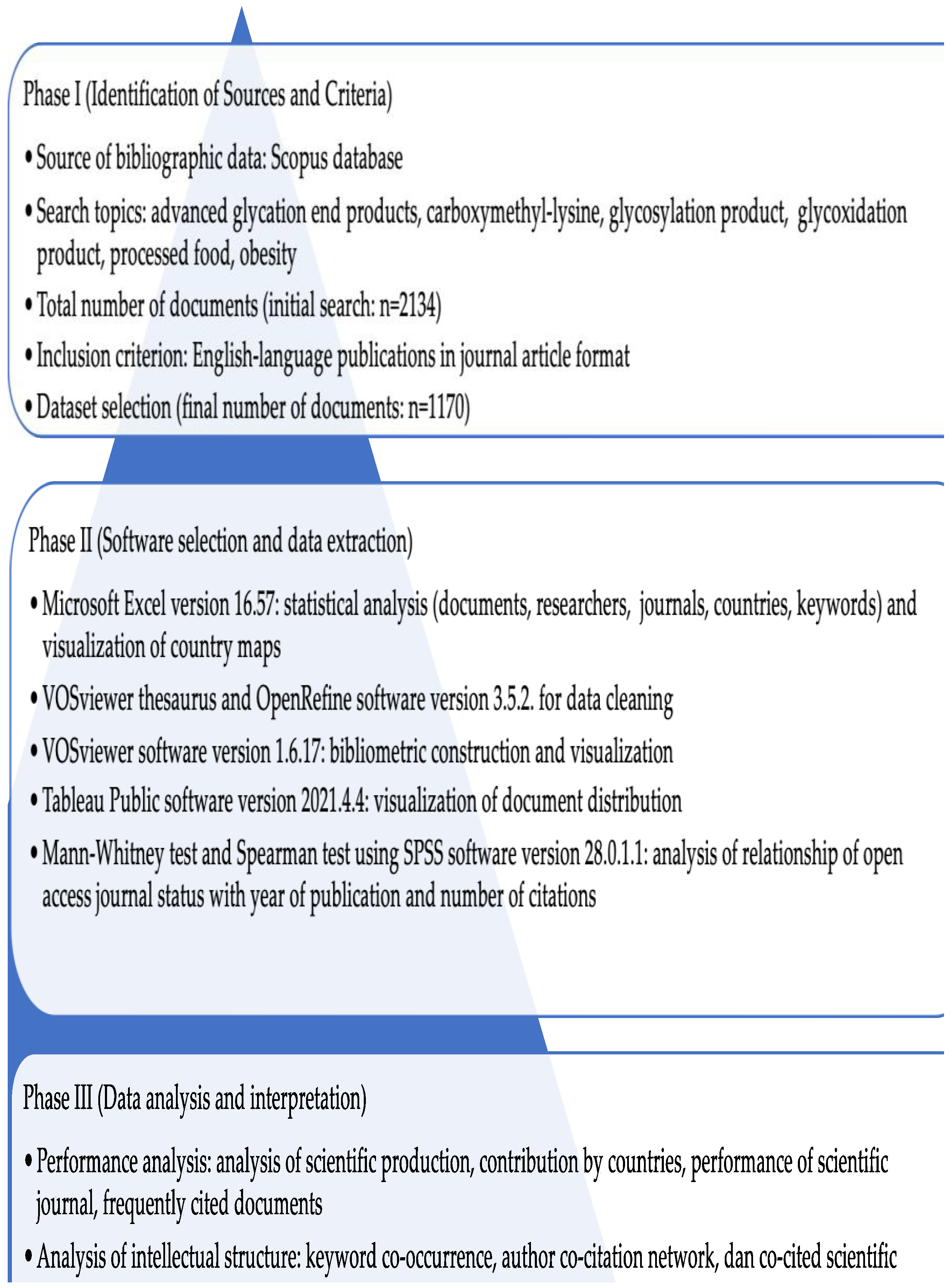
2.2. Phase 2—Software Selection and Data Extraction
2.3. Phase 3—Data Analysis and Interpretation
3. Results
3.1. Performance Analysis
3.1.1. Distribution of Publication by Year
3.1.2. Contributions by Country and Region
3.1.3. Analysis of Journals
3.1.4. Most Frequently Cited Documents
3.1.5. Collaboration between Authors
3.2. Analysis of Intellectual Structure
3.2.1. Analysis of Keywords
3.2.2. Co-Citation Networks of Cited Authors
3.2.3. Co-Citation Source Networks
4. Discussion
5. Conclusions
Supplementary Materials
Author Contributions
Funding
Institutional Review Board Statement
Informed Consent Statement
Data Availability Statement
Acknowledgments
Conflicts of Interest
References
- Nurwanti:, E.; Hadi, H.; Chang, J.-S.; Chao, J.C.J.; Paramashanti, B.A.; Gittelsohn, J.; Bai, C.-H. Rural–urban differences in dietary behavior and obesity: Results of the Riskesdas study in 10–18-year-old Indonesian children and adolescents. Nutrients 2019, 11, 2813. [Google Scholar] [CrossRef] [PubMed]
- Popkin, B.M.; Ng, S.W. The nutrition transition to a stage of high obesity and noncommunicable disease prevalence dominated by ultra-processed foods is not inevitable. Obes. Rev. 2022, 23, e13366. [Google Scholar] [CrossRef] [PubMed]
- Tobias, D.K.; Hall, K.D. Eliminate or reformulate ultra-processed foods? Biological mechanisms matter. Cell Metab. 2021, 33, 2314–2315. [Google Scholar] [CrossRef] [PubMed]
- Van Waateringe, R.P.; Mook-Kanamori, M.J.; Slagter, S.N.; van der Klauw, M.M.; van Vliet-Ostaptchouk, J.V.; Graaff, R.; Lutgers, H.L.; Suhre, K.; El-Din Selim, M.M.; Mook-Kanamori, D.O.; et al. The association between various smoking behaviors, cotinine biomarkers and skin autofluorescence, a marker for advanced glycation end product accumulation. PLoS ONE 2017, 12, e0179330. [Google Scholar] [CrossRef] [PubMed]
- Puddu, A.; Sanguineti, R.; Maggi, D.; Nicolò, M.; Traverso, C.E.; Cordera, R.; Viviani, G.L. Advanced Glycation End-Products and hyperglycemia increase angiopoietin-2 production by impairing angiopoietin-1-tie-2 system. J. Diabetes Res. 2019, 2019, 6198495. [Google Scholar] [CrossRef]
- Lee, H.-W.; Gu, M.; Hur, J.; Park, H.-Y.; Kim, Y.; Ha, S.K. Glycolaldehyde disrupts insulin signaling and glucose uptake through adipogenesis. Appl. Biol. Chem. 2021, 64, 58. [Google Scholar] [CrossRef]
- Wolffenbuttel, B.H.; van Haeften, T.W. Prevention of complications in non-insulin-dependent diabetes mellitus (NIDDM). Drugs 1995, 50, 263–288. [Google Scholar] [CrossRef]
- Ames, J.M. Determination of N epsilon-(carboxymethyl)lysine in foods and related systems. Ann. N. Y. Acad. Sci. 2008, 1126, 20–24. [Google Scholar] [CrossRef]
- Uribarri, J.; Woodruff, S.; Goodman, S.; Cai, W.; Chen, X.; Pyzik, R.; Yong, A.; Striker, G.E.; Vlassara, H. Advanced glycation end products in foods and a practical guide to their reduction in the diet. J. Am. Diet. Assoc 2010, 110, 911–916. [Google Scholar] [CrossRef]
- Hull, G.L.J.; Woodside, J.V.; Ames, J.M.; Cuskelly, G.J. Ne-(carboxymethyl) lysine content of foods commonly consumed in a Western style diet. Food Chem. 2012, 131, 170–174. [Google Scholar] [CrossRef]
- Takeuchi, M.; Takino, J.-I.; Furuno, S.; Shirai, H.; Kawakami, M.; Muramatsu, M.; Kobayashi, Y.; Yamagishi, S.-I. Assessment of the concentrations of various advanced glycation end-products in beverages and foods that are commonly consumed in Japan. PLoS ONE 2015, 10, e0118652. [Google Scholar] [CrossRef] [PubMed]
- He, J.; Zeng, M.; Zheng, Z.; He, Z.; Chen, J. Simultaneous determination of Nε-(carboxymethyl) lysine and Nε-(carboxyethyl) lysine in cereal foods by LC–MS/MS. Eur. Food Res. Technol. 2014, 238, 367–374. [Google Scholar] [CrossRef]
- Scheijen, J.L.J.M.; Clevers, E.; Engelen, L.; Dagnelie, P.C.; Brouns, F.; Stehouwer, C.D.A.; Schalkwijk, C.G. Analysis of advanced glycation endproducts in selected food items by ultra-performance liquid chromatography tandem mass spectrometry: Presentation of a dietary AGE database. Food Chem. 2016, 190, 1145–1150. [Google Scholar] [CrossRef] [PubMed]
- Sharma, C.; Kaur, A.; Thind, S.S.; Singh, B.; Raina, S. Advanced glycation End-products (AGEs): An emerging concern for processed food industries. J. Food Sci. Technol. 2015, 52, 7561–7576. [Google Scholar] [CrossRef]
- Uribarri, J.; del Castillo, M.D.; de la Maza, M.P.; Filip, R.; Gugliucci, A.; Luevano-Contreras, C.; Macías-Cervantes, M.H.; Bastos, D.H.M.; Medrano, A.; Menini, T.; et al. Dietary Advanced Glycation End Products and their role in health and disease. Adv. Nutr. 2015, 6, 461–473. [Google Scholar] [CrossRef]
- Huang, S.; Huang, M.; Dong, X. Advanced Glycation End Products in meat during processing and storage: A review. Food Rev. Int. 2021, 1–17. [Google Scholar] [CrossRef]
- Popkin, B.M. Nutrition transition and the global diabetes epidemic. Curr. Diab. Rep. 2015, 15, 64. [Google Scholar] [CrossRef]
- Cai, W.; Ramdas, M.; Zhu, L.; Chen, X.; Striker, G.E.; Vlassara, H. Oral Advanced Glycation End Products (AGEs) promote insulin resistance and diabetes by depleting the antioxidant defenses AGE receptor-1 and sirtuin 1. Proc. Natl. Acad. Sci. USA 2012, 109, 15888–15893. [Google Scholar] [CrossRef]
- Uribarri, J.; Cai, W.; Sandu, O.; Peppa, M.; Goldberg, T.; Vlassara, H. Diet-derived advanced glycation end products are major contributors to the body’s AGE pool and induce inflammation in healthy subjects. Ann. N. Y. Acad. Sci. 2005, 1043, 461–466. [Google Scholar] [CrossRef]
- Henle, T. AGEs in foods: Do they play a role in uremia? Kidney Int. 2003, 63, S145–S147. [Google Scholar] [CrossRef]
- Öğretmenoğlu, M.; GöKtepe, S.; Atsız, O. A bibliometric analysis of food studies: Evidence from British Food Journal. J. Multidiscip. Acad. Tour. 2021, 7, 67–79. [Google Scholar] [CrossRef]
- Pranckutė, R. Web of Science (WoS) and Scopus: The titans of bibliographic information in today’s academic world. Publications 2021, 9, 12. [Google Scholar] [CrossRef]
- Donthu, N.; Kumar, S.; Mukherjee, D.; Pandey, N.; Lim, W.M. How to conduct a bibliometric analysis: An overview and guidelines. J. Bus. Res. 2021, 133, 285–296. [Google Scholar] [CrossRef]
- Mendez, J.; Xie, J.; Aguilar-Hernández, M.; Méndez-Valenzuela, V. Trends in advanced glycation end products research in diabetes mellitus and its complications. Mol. Cell Biochem. 2010, 341, 33–41. [Google Scholar] [CrossRef]
- Huang, Z.; Zhang, H.; Luo, Y.; Wei, C.; Zhao, Y.; Huang, Y.; Zhang, L.; Chen, W.; He, L.; Liu, H.; et al. The 100 top-cited articles in diabetic kidney disease: A bibliometric analysis. Ren. Fail. 2021, 43, 781–795. [Google Scholar] [CrossRef]
- Bajjou, M.S. List of Scopus Indexed Journals 2022. 2022. Available online: https://www.researchgate.net/publication/357884652_List_of_Scopus_Indexed_Journals_2022 (accessed on 29 March 2022).
- Riccaboni, M.; Verginer, L. The impact of the COVID-19 pandemic on scientific research in the life sciences. PLoS ONE 2022, 17, e0263001. [Google Scholar] [CrossRef]
- Popkin, B.M.; Adair, L.S.; Ng, S.W. Global nutrition transition and the pandemic of obesity in developing countries. Nutr. Rev 2012, 70, 3–21. [Google Scholar] [CrossRef]
- Evans, J.L.; Goldfine, I.D.; Maddux, B.A.; Grodsky, G.M. Oxidative stress and stress-activated signaling pathways: A unifying hypothesis of type 2 diabetes. Endocr. Rev. 2002, 23, 599–622. [Google Scholar] [CrossRef]
- Chassaing, B.; Koren, O.; Goodrich, J.K.; Poole, A.C.; Srinivasan, S.; Ley, R.E.; Gewirtz, A.T. Dietary emulsifiers impact the mouse gut microbiota promoting colitis and metabolic syndrome. Nature 2015, 519, 92–96. [Google Scholar] [CrossRef]
- Bibbins-Domingo, K.; Chertow, G.M.; Coxson, P.G.; Moran, A.; Lightwood, J.M.; Pletcher, M.J.; Goldman, L. Projected Effect of Dietary Salt Reductions on Future Cardiovascular Disease. N. Engl. J. Med. 2010, 362, 590–599. [Google Scholar] [CrossRef]
- WHO. Diet, nutrition and the prevention of chronic diseases: Report of a joint WHO/FAO expert consultation, Geneva, 28 January–1 February 2002. World Health Organ. Tech. Rep. Ser. 2003, 916, 1–149. Available online: https://apps.who.int/iris/handle/10665/42665 (accessed on 20 July 2022).
- Calder, P.C.; Ahluwalia, N.; Brouns, F.; Buetler, T.; Clement, K.; Cunningham, K.; Esposito, K.; Jönsson, L.S.; Kolb, H.; Lansink, M.; et al. Dietary factors and low-grade inflammation in relation to overweight and obesity. Br. J. Nutr. 2011, 106 (Suppl. S3), S1–S78. [Google Scholar] [CrossRef] [PubMed]
- Wada, J.; Makino, H. Inflammation and the pathogenesis of diabetic nephropathy. Clin. Sci. 2013, 124, 139–152. [Google Scholar] [CrossRef] [PubMed]
- Fiorentino, T.V.; Prioletta, A.; Zuo, P.; Folli, F. Hyperglycemia-induced oxidative stress and its role in diabetes mellitus related cardiovascular diseases. Curr. Pharm. Des. 2013, 19, 5695–5703. [Google Scholar] [CrossRef]
- Tanji, N.; Markowitz, G.S.; Fu, C.; Kislinger, T.; Taguchi, A.; Pischetsrieder, M.; Stern, D.; Schmidt, A.M.; D’Agati, V.D. Expression of advanced glycation end products and their cellular receptor RAGE in diabetic nephropathy and nondiabetic renal disease. J. Am. Soc. Nephrol. 2000, 11, 1656–1666. [Google Scholar] [CrossRef]
- Hall, K.D.; Ayuketah, A.; Brychta, R.; Cai, H.; Cassimatis, T.; Chen, K.Y.; Chung, S.T.; Costa, E.; Courville, A.; Darcey, V.; et al. Ultra-processed diets cause excess calorie intake and weight gain: An inpatient randomized controlled trial of ad libitum food intake. Cell Metab. 2019, 30, 67–77.e63. [Google Scholar] [CrossRef]
- Conway, G.; Dewailly, D.; Diamanti-Kandarakis, E.; Escobar-Morreale, H.F.; Franks, S.; Gambineri, A.; Kelestimur, F.; Macut, D.; Micic, D.; Pasquali, R.; et al. The polycystic ovary syndrome: A position statement from the European Society of Endocrinology. Eur. J. Endocrinol. 2014, 171, P1–P29. [Google Scholar] [CrossRef]
- Donath, M.Y.; Gross, D.J.; Cerasi, E.; Kaiser, N. Hyperglycemia-induced beta-cell apoptosis in pancreatic islets of Psammomys obesus during development of diabetes. Diabetes 1999, 48, 738–744. [Google Scholar] [CrossRef]
- Scuteri, A.; Najjar, S.S.; Muller, D.C.; Andres, R.; Hougaku, H.; Metter, E.J.; Lakatta, E.G. Metabolic syndrome amplifies the age-associated increases in vascular thickness and stiffness. J. Am. Coll. Cardiol. 2004, 43, 1388–1395. [Google Scholar] [CrossRef]
- Lontchi-Yimagou, E.; Sobngwi, E.; Matsha, T.E.; Kengne, A.P. Diabetes mellitus and inflammation. Curr. Diab. Rep. 2013, 13, 435–444. [Google Scholar] [CrossRef]
- Louzada, M.L.; Baraldi, L.G.; Steele, E.M.; Martins, A.P.; Canella, D.S.; Moubarac, J.C.; Levy, R.B.; Cannon, G.; Afshin, A.; Imamura, F.; et al. Consumption of ultra-processed foods and obesity in Brazilian adolescents and adults. Prev. Med. 2015, 81, 9–15. [Google Scholar] [CrossRef] [PubMed]
- Thamrin, S.A.; Arsyad, D.S.; Kuswanto, H.; Lawi, A.; Arundhana, A.I. Obesity risk-factor variation based on island clusters: A secondary analysis of Indonesian Basic Health Research 2018. Nutrients 2022, 14, 971. [Google Scholar] [CrossRef] [PubMed]
- Wulan, S.N.; Raza, Q.; Prasmita, H.S.; Martati, E.; Maligan, J.M.; Mageshwari, U.; Fatima, I.; Plasqui, G. Energy metabolism in relation to diet and physical activity: A South Asian perspective. Nutrients 2021, 13, 3776. [Google Scholar] [CrossRef] [PubMed]
- Zhou, M. The shifting income-obesity relationship: Conditioning effects from economic development and globalization. SSM Popul. Health 2021, 15, 100849. [Google Scholar] [CrossRef]
- Bucala, R.; Makita, Z.; Koschinsky, T.; Cerami, A.; Vlassara, H. Lipid advanced glycosylation: Pathway for lipid oxidation in vivo. Proc. Natl. Acad. Sci. USA 1993, 90, 6434–6438. [Google Scholar] [CrossRef]
- Leurs, P.; Lindholm, B. The AGE–RAGE pathway and its relation to cardiovascular disease in patients with chronic kidney disease. Arch. Med. Res 2013, 44, 601–610. [Google Scholar] [CrossRef] [PubMed]
- Zhuang, A.; Yap, F.Y.; Bruce, C.; Leung, C.; Plan, M.R.; Sullivan, M.A.; Herath, C.; McCarthy, D.; Sourris, K.C.; Kantharidis, P.; et al. Increased liver AGEs induce hepatic injury mediated through an OST48 pathway. Sci. Rep. 2017, 7, 12292. [Google Scholar] [CrossRef] [PubMed]
- Al-Dalaeen, A.; Al-Domi, H. Advanced Glycation End Products: Mechanisms in the pathogenesis of type 2 Diabetes and its complications. J. Res. Diabetes Metab. 2018, 4, 016–020. [Google Scholar]
- Goldin, A.; Beckman, J.A.; Scmidt, A.M.; Creagen, M.A. Advanced glycation end products: Sparking the development of diabetic vascular injury. Circulation 2006, 114, 597–605. [Google Scholar] [CrossRef]
- Goldberg, T.; Cai, W.; Peppa, M.; Dardaine, V.; Baliga, B.S.; Uribarri, J.; Vlassara, H. Advanced glycoxidation end products in commonly consumed foods. J. Am. Diet. Assoc. 2004, 104, 1287–1291. [Google Scholar] [CrossRef]
- Liman, P.B.; Djuwita, R.; Agustina, R. Database development of carboxymethyl lysine content in foods consumed by Indonesian women in two selected provinces. J. Int. Dent. Med. Res. 2019, 12, 268–277. [Google Scholar]
- Laakso, M.; Welling, P.; Bukvova, H.; Nyman, L.; Björk, B.-C.; Hedlund, T. The development of open access journal publishing from 1993 to 2009. PLoS ONE 2011, 6, e20961. [Google Scholar] [CrossRef] [PubMed]
- Björk, B.-C.; Solomon, D. Open access versus subscription journals: A comparison of scientific impact. BMC Med. 2012, 10, 73. [Google Scholar] [CrossRef] [PubMed]
- Xafis, V.; Labude, M.K. Openness in big data and data repositories. Asian Bioeth. Rev. 2019, 11, 255–273. [Google Scholar] [CrossRef]
- Raghupathi, W.; Raghupathi, V. Big data analytics in healthcare: Promise and potential. Health Inf. Sci. Syst. 2014, 2, 3. [Google Scholar] [CrossRef]
- Pandita, R.; Singh, S. A Study of Distribution and Growth of Open Access Research Journals Across the World. Publ. Res. Q. 2022, 38, 131–149. [Google Scholar] [CrossRef]
- Li, Y.; Wu, C.; Yan, E.; Li, K. Will open access increase journal CiteScores? An empirical investigation over multiple disciplines. PLoS ONE 2018, 13, e0201885. [Google Scholar] [CrossRef]
- Studenic, P.; Ospelt, C. Altimetric—Does social media impact citation rate in rheumatology journals? Ann. Rheum. Dis. 2020, 79, 208. [Google Scholar] [CrossRef]
- Sjögårde, P.; Didegah, F. The association between topic growth and citation impact of research publications. Scientometrics 2022, 127, 1903–1921. [Google Scholar] [CrossRef]
- Vlassara, H.; Striker, G.E. AGE restriction in diabetes mellitus: A paradigm shift. Nat. Rev. Endocrinol. 2011, 7, 526–539. [Google Scholar] [CrossRef]
- Vlassara, H.; Cai, W.; Goodman, S.; Pyzik, R.; Yong, A.; Chen, X.; Zhu, L.; Neade, T.; Beeri, M.; Silverman, J.M.; et al. Protection against loss of innate defenses in adulthood by low advanced glycation end products (AGE) intake: Role of the antiinflammatory AGE receptor-1. J. Clin. Endocrinol. Metab. 2009, 94, 4483–4491. [Google Scholar] [CrossRef] [PubMed]
- Cai, W.; He, J.C.; Zhu, L.; Peppa, M.; Lu, C.; Uribarri, J.; Vlassara, H. High levels of dietary advanced glycation end products transform low-density lipoprotein into a potent redox-sensitive mitogen-activated protein kinase stimulant in diabetic patients. Circulation 2004, 110, 285–291. [Google Scholar] [CrossRef] [PubMed]
- Gupta, A.; Uribarri, J. Dietary advanced glycation end products and their potential role in cardiometabolic disease in children. Horm. Res. Paediatr. 2016, 85, 291–300. [Google Scholar] [CrossRef] [PubMed]
- Uribarri, J.; Cai, W.; Pyzik, R.; Goodman, S.; Chen, X.; Zhu, L.; Ramdas, M.; Striker, G.E.; Vlassara, H. Suppression of native defense mechanisms, SIRT1 and PPARγ, by dietary glycoxidants precedes disease in adult humans; relevance to lifestyle-engendered chronic diseases. Amino Acids 2014, 46, 301–309. [Google Scholar] [CrossRef]
- Stefan, N.; Häring, H.U.; Hu, F.B.; Schulze, M.B. Metabolically healthy obesity: Epidemiology, mechanisms, and clinical implications. Lancet Diabetes Endocrinol. 2013, 1, 152–162. [Google Scholar] [CrossRef] [PubMed]
- Baye, E.; Kiriakova, V.; Uribarri, J.; Moran, L.J.; de Courten, B. Consumption of diets with low advanced glycation end products improves cardiometabolic parameters: Meta-analysis of randomised controlled trials. Sci. Rep. 2017, 7, 2266. [Google Scholar] [CrossRef]
- Uribarri, J.; Cai, W.; Woodward, M.; Tripp, E.; Goldberg, L.; Pyzik, R.; Yee, K.; Tansman, L.; Chen, X.; Mani, V.; et al. Elevated serum advanced glycation endproducts in obese indicate risk for the metabolic syndrome: A link between healthy and unhealthy obesity? J. Clin. Endocrinol. Metab. 2015, 100, 1957–1966. [Google Scholar] [CrossRef]
- De Courten, B.; Baye, E. Effects of a low-AGE diet on insulin sensitivity. In Dietary AGEs and Their Role in Health and Disease; Uribarri, J., Ed.; Taylor & Francis Group, LLC: New York, NY, USA, 2018; pp. 329–337. [Google Scholar]
- McGlashan, S.; Yu, L.; Vickers, M.; Haysom, S.S.; Barker, C.; Leung, S.; Firth, E. Diet-induced obesity may initiate advanced glycation end-product-mediated inflammation in articular cartilage. Osteoarthr. Cartil. 2016, 24, S142–S143. [Google Scholar] [CrossRef]
- Luévano-Contreras, C.; Gómez-Ojeda, A.; Macías-Cervantes, M.H.; Garay-Sevilla, M.E. Dietary Advanced Glycation End Products and Cardiometabolic Risk. Curr. Diab. Rep. 2017, 17, 63. [Google Scholar] [CrossRef]
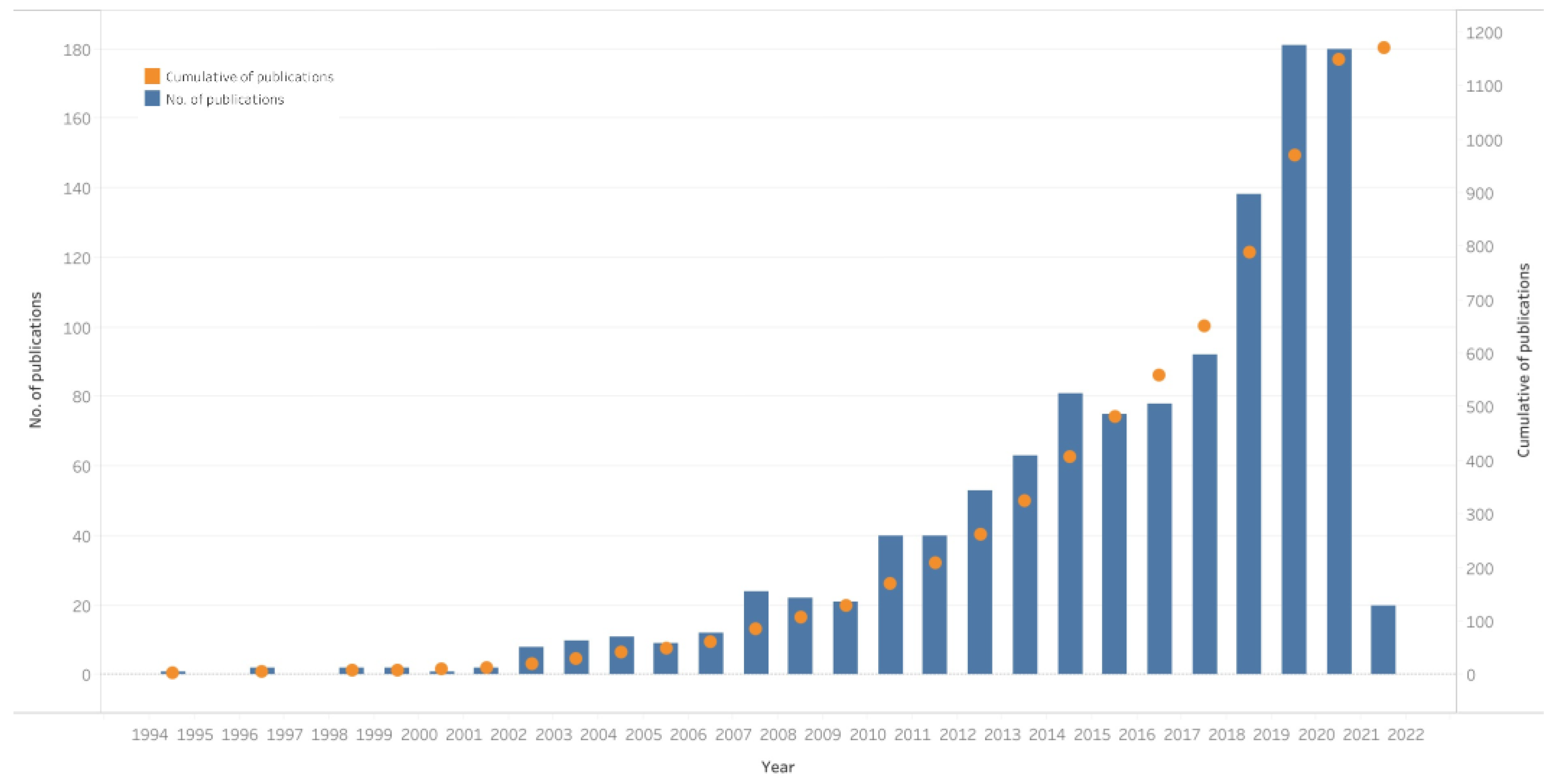
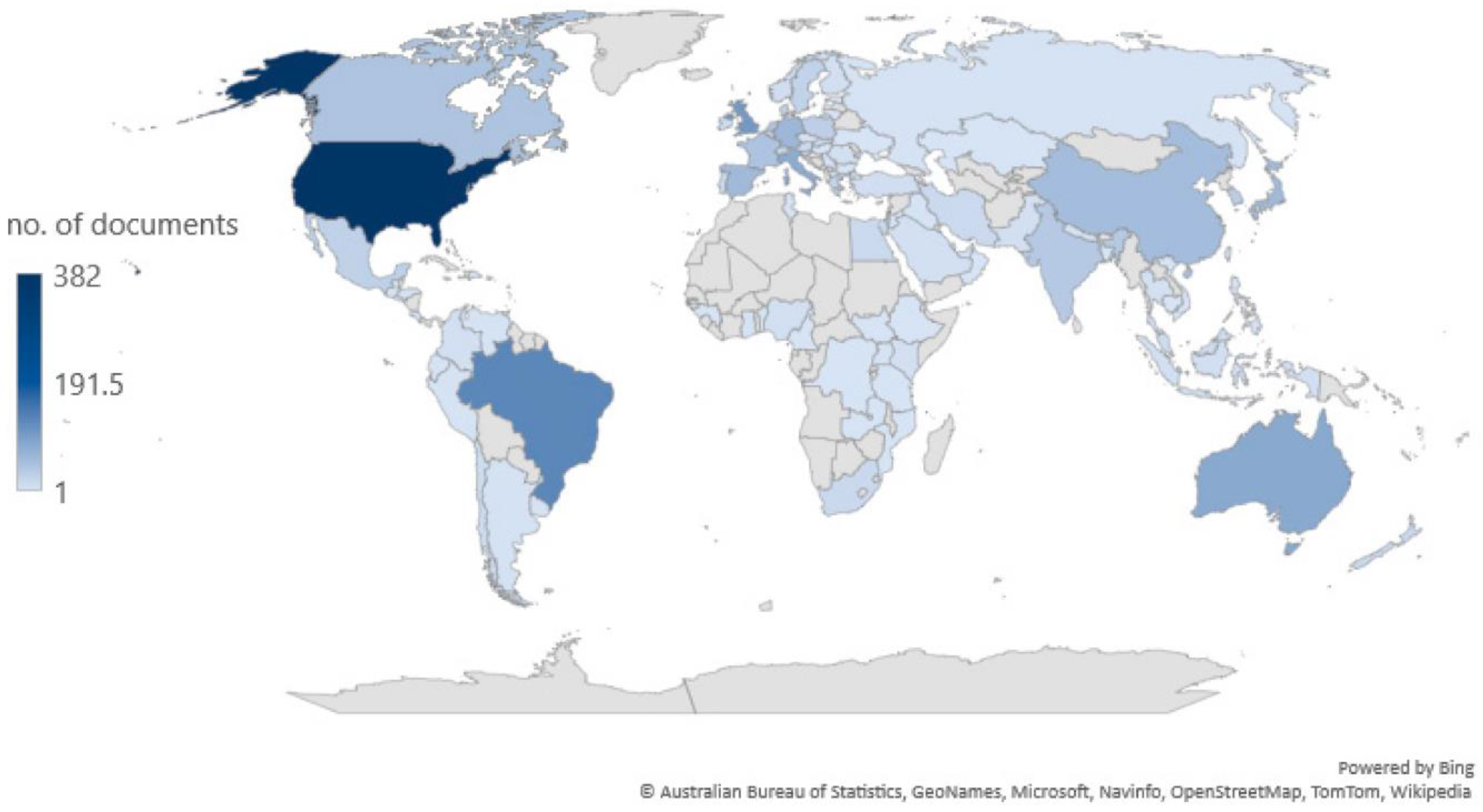
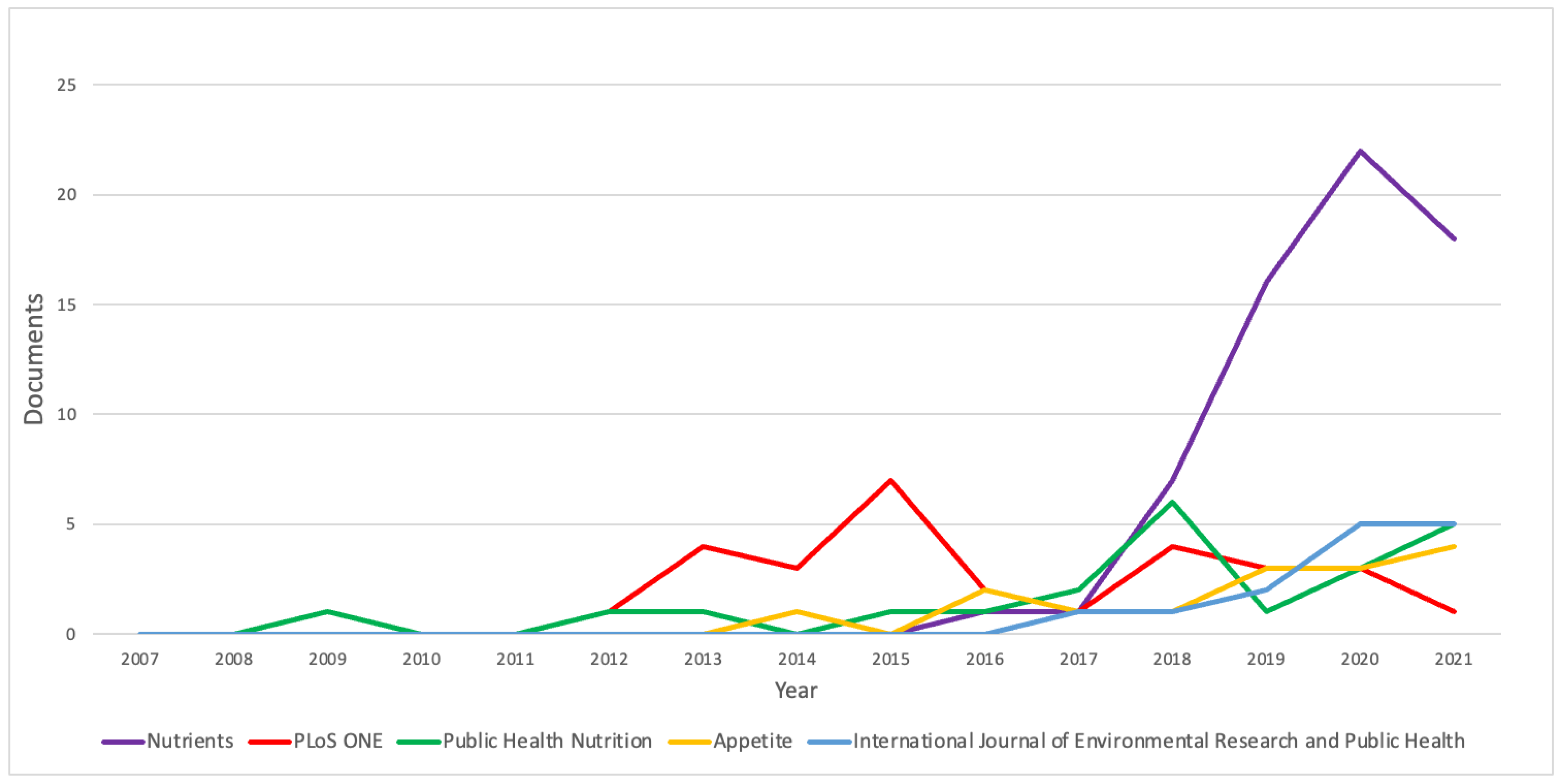
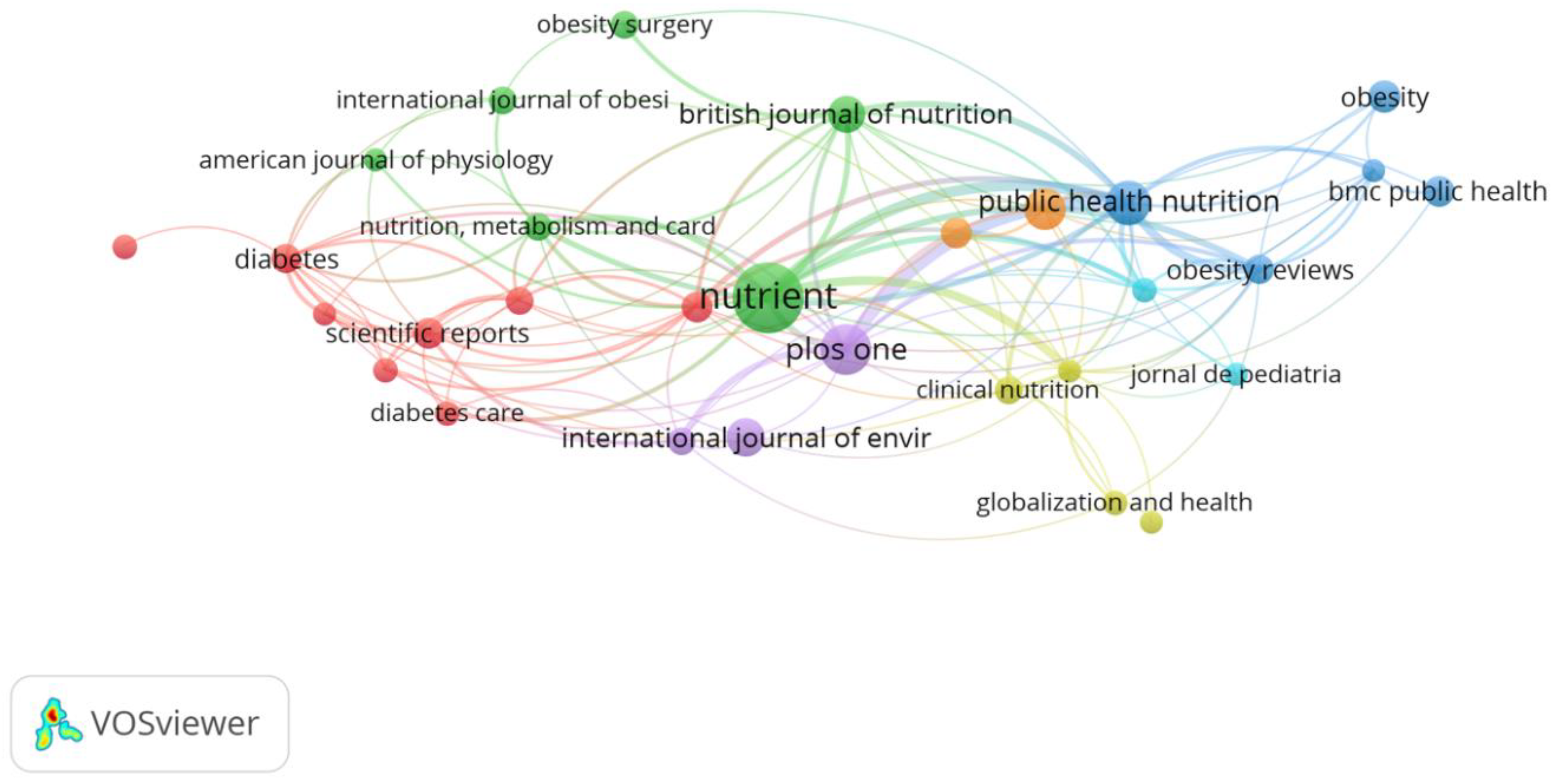
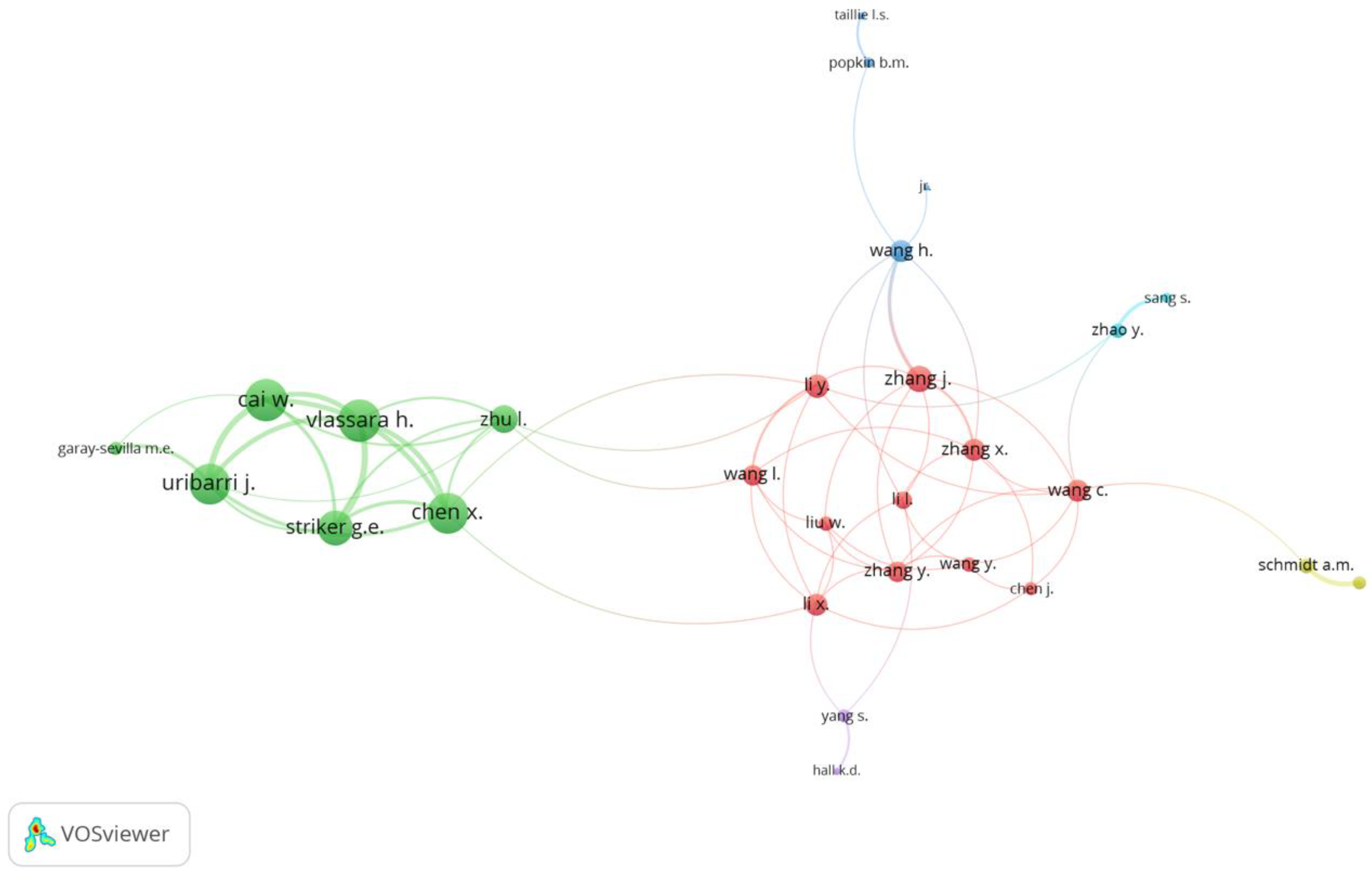


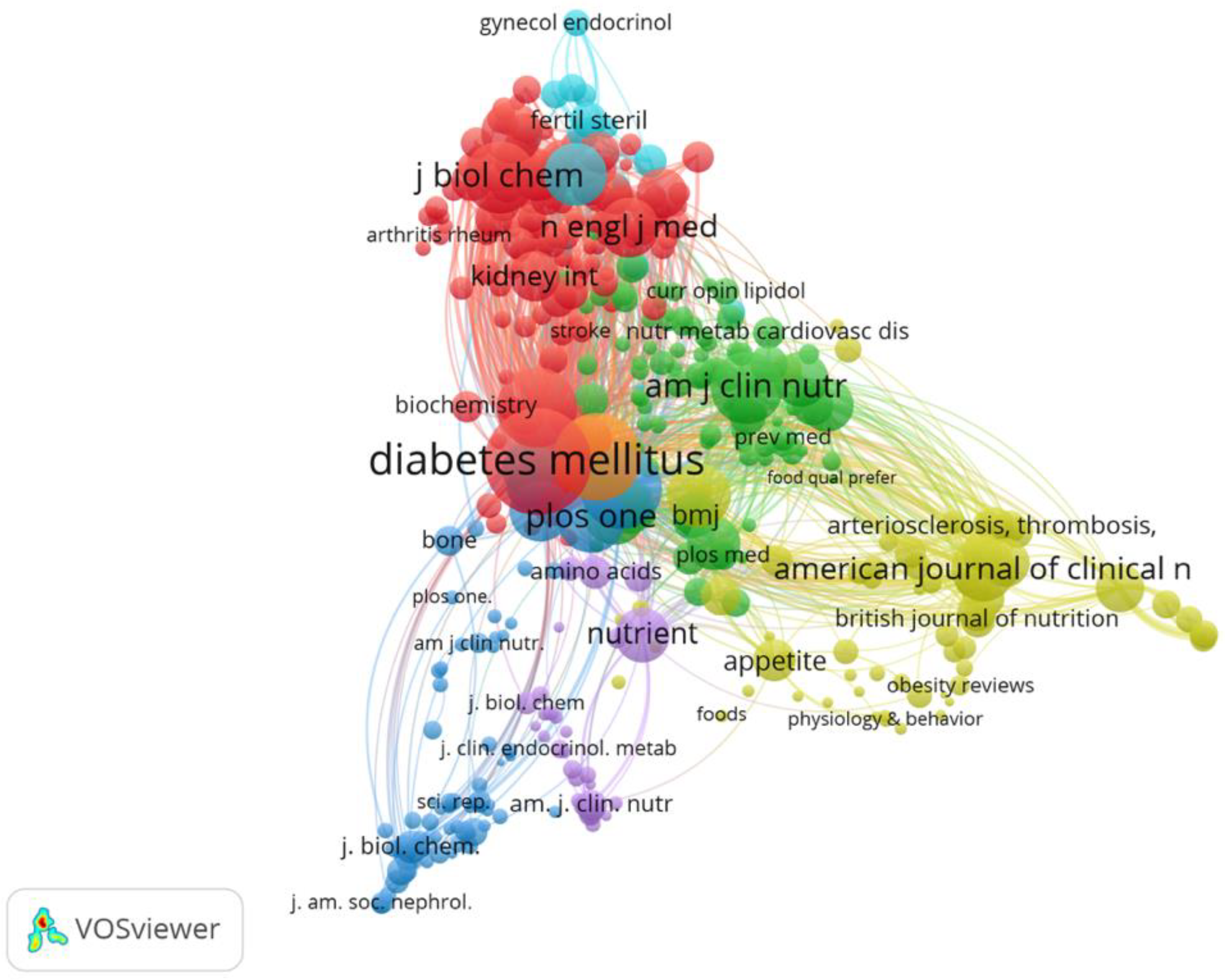
| No. | Country | Region | Documents | Citations | Links | Total Link Strength |
|---|---|---|---|---|---|---|
| 1 | United States | America | 382 | 19,362 | 103 | 55,724 |
| 2 | Brazil | America | 126 | 3611 | 94 | 27,028 |
| 3 | United Kingdom | Europe | 102 | 4203 | 98 | 27,961 |
| 4 | Australia | Oceania | 81 | 2551 | 100 | 18,628 |
| 5 | Italy | Europe | 78 | 3988 | 93 | 20,707 |
| 6 | Germany | Europe | 61 | 2715 | 94 | 16,838 |
| 7 | Spain | Europe | 58 | 2677 | 97 | 18,193 |
| 8 | Japan | Asia | 57 | 2028 | 68 | 7452 |
| 9 | China | Asia | 53 | 1145 | 87 | 6630 |
| 10 | France | Europe | 45 | 2337 | 94 | 12,203 |
| 11 | Canada | America | 44 | 1687 | 94 | 9564 |
| 12 | Netherlands | Europe | 38 | 2009 | 88 | 13,575 |
| 13 | India | Asia | 37 | 408 | 83 | 3124 |
| 14 | South Korea | Asia | 30 | 283 | 83 | 4140 |
| 15 | Poland | Europe | 29 | 342 | 69 | 2494 |
| Cluster | Documents | Citations | Links | Total Link Strength | Country |
|---|---|---|---|---|---|
| 1 | 382 | 19,362 | 101 | 55,676 | United States |
| Red | 16 | 484 | 78 | 4551 | New Zealand |
| (32 nodes) | 16 | 457 | 82 | 4448 | South Africa |
| 2 | 57 | 2028 | 67 | 7451 | Japan |
| Green | 53 | 1145 | 87 | 6630 | China |
| (15 nodes) | 37 | 408 | 83 | 3124 | India |
| 3 | 78 | 3988 | 91 | 20,700 | Italy |
| Blue | 61 | 2715 | 92 | 16,835 | Germany |
| (14 nodes) | 14 | 168 | 60 | 1439 | Egypt |
| 4 | 24 | 648 | 24 | 648 | Sweden |
| Yellow | 11 | 101 | 11 | 101 | Malaysia |
| (8 nodes) | 6 | 48 | 6 | 48 | Nigeria |
| 5 | 58 | 2677 | 94 | 18,123 | Spain |
| Violet | 27 | 327 | 88 | 5631 | Mexico |
| (7 nodes) | 16 | 1626 | 74 | 3954 | Israel |
| 6 | 38 | 2009 | 87 | 13,574 | Netherlands |
| Light Blue | 22 | 821 | 81 | 11,929 | Denmark |
| (7 nodes) | 20 | 1408 | 73 | 3737 | Greece |
| 7 | 18 | 1369 | 78 | 5208 | Belgium |
| Orange | 15 | 517 | 65 | 1908 | Portugal |
| (6 nodes) | 3 | 1 | 47 | 883 | Cyprus |
| 8 | 81 | 2551 | 98 | 18,588 | Australia |
| Brown | 45 | 2337 | 92 | 12,116 | France |
| (5 nodes) | 1 | 302 | 26 | 467 | Cameroon |
| 9 | 126 | 3611 | 91 | 26,909 | Brazil |
| Light Red | 44 | 1687 | 94 | 9564 | Canada |
| (4 nodes) | 5 | 114 | 58 | 799 | Hong Kong |
| 10 | 102 | 4203 | 96 | 27,949 | United Kingdom |
| Peach | 1 | 1 | 4 | 237 | Oman |
| (3 nodes) | 1 | 1 | 4 | 237 | South Sudan |
| 11 | 12 | 180 | 86 | 5615 | Ireland |
| Light Violet | 7 | 254 | 58 | 3536 | Romania |
| (3 nodes) | 1 | 43 | 16 | 60 | El Salvador |
| Variable | Non-Open Access (n = 457) | Open Access (n = 713) | p Value |
|---|---|---|---|
| Year (in years) | 2016 (2012–2020) ‡,** | 2018 (2015–2020) ‡,** | <0.001 |
| Citations | 7 (2–23) ‡,* | 11 (2–31) ‡,* | 0.007 |
| Ranking | Journal | Print ISSN | E-ISSN | Country | Documents | % of Document Total | Citation | Q | h-Index | SJR (2020) | SNIP (2020) | Open Access (Feb 2022) |
|---|---|---|---|---|---|---|---|---|---|---|---|---|
| 1 | Nutrients | 20726643 | Switzerland | 65 | 5.6 | 683 | 1 | 115 | 1.418 | 1.603 | Yes | |
| 2 | PLoS ONE | 19326203 | United States | 29 | 2.5 | 971 | 1 | 332 | 0.990 | 1.349 | Yes | |
| 3 | Public Health Nutrition | 13689800 | 14752727 | United Kingdom | 22 | 1.9 | 843 | 1 | 137 | 1.166 | 1.368 | Yes |
| 4 | Appetite | 1956663 | 10958304 | United States | 18 | 1.5 | 174 | 1 | 144 | 1.131 | 1.448 | Yes |
| 5 | International Journal of Environmental Research and Public Health | 16617827 | 16604601 | Switzerland | 16 | 1.4 | 39 | 2 | 113 | 0.747 | 1.356 | Yes |
| 6 | British Journal of Nutrition | 71145 | 14752662 | United Kingdom | 15 | 1.3 | 1060 | 1 | 188 | 1.073 | 1.194 | No |
| 7 | Obesity | 19307381 | United States | 11 | 0.9 | 372 | 1 | 199 | 1.438 | 1.356 | No | |
| 8 | BMC Public Health | 14712458 | United Kingdom | 10 | 0.9 | 118 | 1 | 143 | 1.230 | 1.656 | Yes | |
| 9 | Medical Hypotheses | 3069877 | 15322777 | United States | 10 | 0.9 | 324 | 3 | 87 | 0.441 | 0.530 | Yes |
| 10 | European Journal of Nutrition | 14366207 | 14366215 | Germany | 9 | 0.8 | 218 | 1 | 96 | 1.321 | 1.532 | No |
| 11 | Scientific Reports | 20452322 | United Kingdom | 9 | 0.8 | 70 | 1 | 213 | 1.240 | 1.377 | Yes | |
| 12 | Diabetes | 121797 | United States | 8 | 0.7 | 1080 | 1 | 330 | 3.219 | 1.901 | No | |
| 13 | Obesity Reviews | 14677881 | 1467789X | United Kingdom | 8 | 0.7 | 613 | 1 | 162 | 2.845 | 3.056 | Yes |
| 14 | American Journal of Clinical Nutrition | 29165 | 19383207 | United States | 7 | 0.6 | 360 | 1 | 336 | 2.608 | 2.294 | Yes |
| 15 | Clinical Nutrition | 2615614 | 15321983 | United States | 7 | 0.6 | 49 | 1 | 140 | 1.915 | 2.517 | No |
| No. | Authors | Year | Title | Number of Citations | Reference Number |
|---|---|---|---|---|---|
| 1 | Popkin, B.M. | 2012 | Global nutrition transition and the pandemic of obesity in developing countries | 2189 | [28] |
| 2 | Evans, J.L. | 2002 | Oxidative Stress and Stress-Activated Signaling Pathways: A Unifying Hypothesis of Type 2 Diabetes | 1680 | [29] |
| 3 | Chassaing, B. | 2015 | Dietary emulsifiers impact the mouse gut microbiota promoting colitis and metabolic syndrome | 902 | [30] |
| 4 | Bibbins-Domingo, K. | 2010 | Projected effect of dietary salt reductions on future cardiovascular disease | 889 | [31] |
| 5 | World Health Organization | 2003 | Diet, nutrition and the prevention of chronic diseases | 796 | [32] |
| 6 | Calder, P.C. | 2011 | Dietary factors and low-grade inflammation in relation to overweight and obesity | 600 | [33] |
| 7 | Wada, J. | 2013 | Inflammation and the pathogenesis of diabetic nephropathy | 430 | [34] |
| 8 | Fiorentino, T.V. | 2013 | Hyperglycemia-induced Oxidative Stress and its Role in Diabetes Mellitus Related Cardiovascular Diseases | 401 | [35] |
| 9 | Tanji, N. | 2000 | Expression of advanced glycation end products and their cellular receptor RAGE in diabetic nephropathy and nondiabetic renal disease | 390 | [36] |
| 10 | Hall, K.D. | 2019 | Ultra-Processed Diets Cause Excess Calorie Intake and Weight Gain: An Inpatient Randomized Controlled Trial of Ad Libitum Food Intake | 368 | [37] |
| 11 | Conway, G. | 2014 | The polycystic ovary syndrome: a position statement from the European Society of Endocrinology | 364 | [38] |
| 12 | Donath, M.Y. | 1999 | Hyperglycemia-induced beta-cell apoptosis in pancreatic islets of Psammomys obesus during development of diabetes. | 352 | [39] |
| 13 | Scuteri, A. | 2004 | Metabolic syndrome amplifies the age-associated increases in vascular thickness and stiffness | 348 | [40] |
| 14 | Lontchi-Yimagou, E. | 2013 | Diabetes Mellitus and Inflammation | 302 | [41] |
| 15 | Louzada, M.L.C. | 2015 | Consumption of ultra-processed foods and obesity in Brazilian adolescents and adults | 294 | [42] |
| Cluster | Co-Occurrences | Links | Total Link Strength | Author Keyword |
|---|---|---|---|---|
| 1 Red (19 nodes) | 130 | 33 | 195 | AGEs |
| 86 | 24 | 132 | Diabetes Mellitus | |
| 66 | 26 | 119 | Oxidative stress | |
| 65 | 23 | 122 | Inflammation | |
| 58 | 24 | 88 | Age receptor | |
| 51 | 25 | 101 | Insulin resistance | |
| 51 | 34 | 103 | Metabolic syndrome | |
| 46 | 23 | 62 | Diabetes Mellitus, type 2 | |
| 18 | 10 | 31 | Biomarker | |
| 18 | 18 | 37 | Glycation | |
| 14 | 8 | 17 | Antioxidant | |
| 14 | 13 | 25 | Atherosclerosis | |
| 14 | 11 | 25 | Methylglyoxal | |
| 13 | 7 | 11 | Diabetic nephropathy | |
| 12 | 13 | 28 | High-fat diet | |
| 11 | 10 | 16 | Aging | |
| 11 | 14 | 25 | Bariatric surgery | |
| 10 | 10 | 22 | PCOS | |
| 10 | 8 | 18 | Skin autofluorescence | |
| 2 Green (18 nodes) | 68 | 31 | 105 | Ultra-processed food |
| 55 | 34 | 107 | Diet | |
| 42 | 24 | 83 | Overweight | |
| 40 | 27 | 74 | Nutrition | |
| 30 | 20 | 47 | Child | |
| 29 | 22 | 57 | Adolescent | |
| 29 | 18 | 37 | Dietary pattern | |
| 29 | 19 | 43 | Processed food | |
| 26 | 12 | 33 | Nutrition transition | |
| 25 | 20 | 44 | Body mass index | |
| 19 | 16 | 41 | Food consumption | |
| 16 | 11 | 28 | Food processing | |
| 15 | 12 | 28 | Diet quality | |
| 14 | 14 | 32 | Risk factor | |
| 13 | 10 | 24 | Food | |
| 12 | 6 | 16 | Non-communicable diseases | |
| 10 | 13 | 20 | Adult | |
| 10 | 8 | 14 | Weight loss | |
| 3 Blue (9 nodes) | 310 | 50 | 517 | Obesity |
| 16 | 17 | 26 | Physical activity | |
| 15 | 10 | 13 | Childhood obesity | |
| 15 | 6 | 18 | Food addiction | |
| 13 | 15 | 25 | Public health | |
| 12 | 10 | 20 | Metabolism | |
| 11 | 15 | 22 | Epidemiology | |
| 11 | 10 | 16 | Food environment | |
| 11 | 3 | 5 | Food policy | |
| 4 Yellow (7 nodes) | 30 | 27 | 75 | Cardiovascular disease |
| 16 | 13 | 22 | Hypertension | |
| 15 | 12 | 22 | Fast food | |
| 13 | 15 | 28 | Hyperglycemia | |
| 11 | 7 | 17 | Glucose | |
| 11 | 10 | 16 | Sugar | |
| 10 | 9 | 16 | Fructose |
| Ranking | Authors | Co-citations | Links | Total Link Strength |
|---|---|---|---|---|
| 1 | Monteiro, C.A. | 737 | 213 | 54,339 |
| 2 | Popkin, B.M. | 517 | 276 | 34,295 |
| 3 | Vlassara, H. | 495 | 269 | 58,763 |
| 4 | Schmidt, A.M. | 494 | 237 | 47,118 |
| 5 | Cannon, G. | 464 | 205 | 33,401 |
| 6 | Levy, R.B. | 445 | 204 | 32,228 |
| 7 | Cai, W. | 392 | 270 | 44.311 |
| 8 | Yamagishi, S. | 369 | 239 | 32,718 |
| 9 | Moubarac, J.C. | 333 | 195 | 25,603 |
| 10 | Uribarri, J. | 319 | 245 | 31,732 |
| 11 | Thornalley, P.J. | 287 | 226 | 58,303 |
| 12 | Takeuchi, M. | 247 | 237 | 24.424 |
| 13 | Hu, F.B. | 242 | 296 | 23,864 |
| 14 | Claro, R.M. | 230 | 181 | 15,166 |
| 15 | Brownlee, M. | 212 | 277 | 27,471 |
| Ranking | Source | Citations | Links | Total Link Strength |
|---|---|---|---|---|
| 1 | Diabetes | 1236 | 409 | 30,087 |
| 2 | Diabetes Care | 845 | 420 | 20,139 |
| 3 | PLoS ONE | 816 | 816 | 8106 |
| 4 | The American Journal of Clinical Nutrition | 674 | 123 | 9349 |
| 5 | Circulation | 668 | 415 | 14,980 |
| 6 | Nutrients | 625 | 209 | 3459 |
| 7 | Diabetologia | 580 | 403 | 17,875 |
| 8 | The Lancet | 571 | 73 | 8304 |
| 9 | Journal of Biological Chemistry | 435 | 194 | 13,240 |
| 10 | Nature | 431 | 169 | 8228 |
| 11 | The Journal of Clinical Endocrinology and Metabolism | 421 | 174 | 7334 |
| 12 | The New England Journal of Medicine | 364 | 335 | 9194 |
| 13 | Atherosclerosis | 328 | 398 | 9055 |
| 14 | The Journal of Clinical Investigation | 322 | 230 | 9765 |
| 15 | American Journal of Clinical Nutrition | 182 | 199 | 7733 |
Publisher’s Note: MDPI stays neutral with regard to jurisdictional claims in published maps and institutional affiliations. |
© 2022 by the authors. Licensee MDPI, Basel, Switzerland. This article is an open access article distributed under the terms and conditions of the Creative Commons Attribution (CC BY) license (https://creativecommons.org/licenses/by/4.0/).
Share and Cite
Liman, P.B.; Anastasya, K.S.; Salma, N.M.; Yenny, Y.; Faradilla, M.A. Research Trends in Advanced Glycation End Products and Obesity: Bibliometric Analysis. Nutrients 2022, 14, 5255. https://doi.org/10.3390/nu14245255
Liman PB, Anastasya KS, Salma NM, Yenny Y, Faradilla MA. Research Trends in Advanced Glycation End Products and Obesity: Bibliometric Analysis. Nutrients. 2022; 14(24):5255. https://doi.org/10.3390/nu14245255
Chicago/Turabian StyleLiman, Patricia Budihartanti, Karina Shasri Anastasya, Nabila Maudy Salma, Yenny Yenny, and Meutia Atika Faradilla. 2022. "Research Trends in Advanced Glycation End Products and Obesity: Bibliometric Analysis" Nutrients 14, no. 24: 5255. https://doi.org/10.3390/nu14245255
APA StyleLiman, P. B., Anastasya, K. S., Salma, N. M., Yenny, Y., & Faradilla, M. A. (2022). Research Trends in Advanced Glycation End Products and Obesity: Bibliometric Analysis. Nutrients, 14(24), 5255. https://doi.org/10.3390/nu14245255






